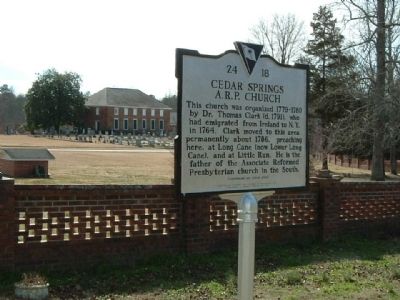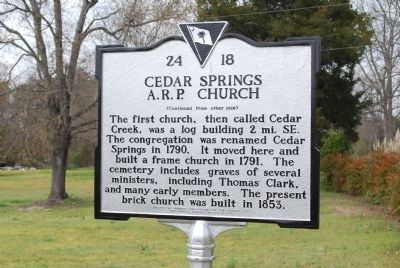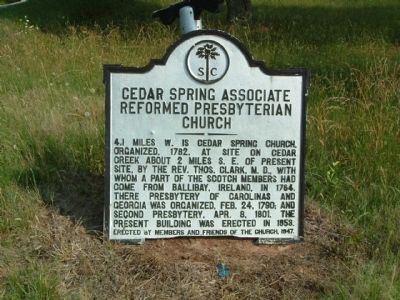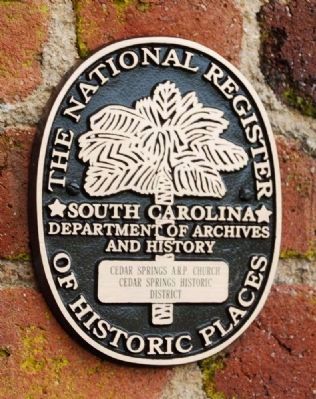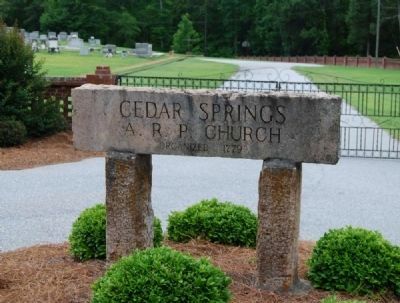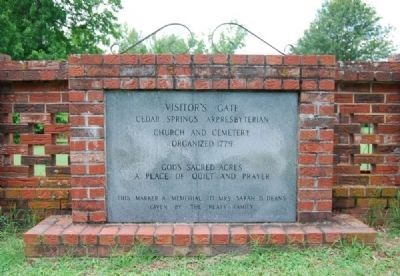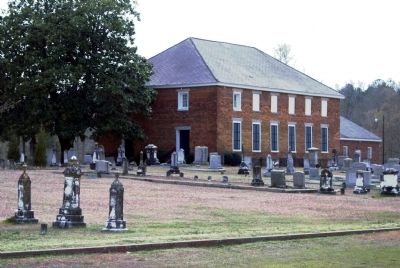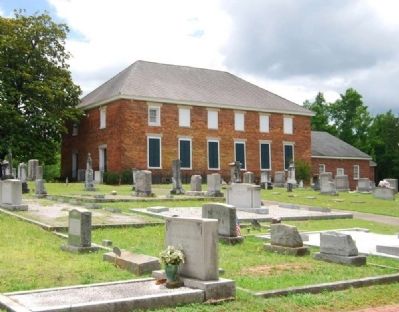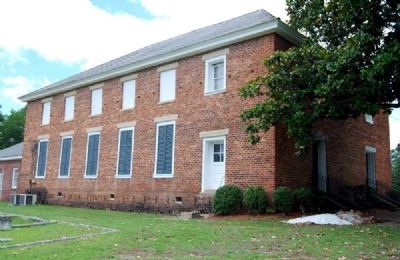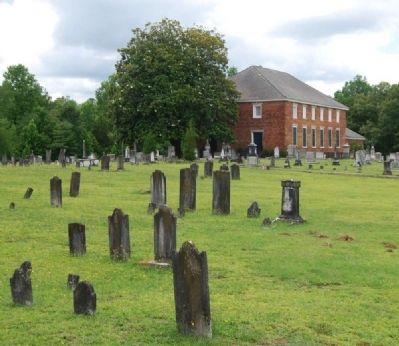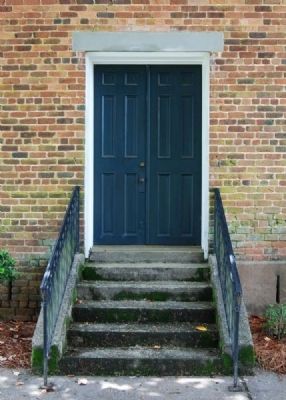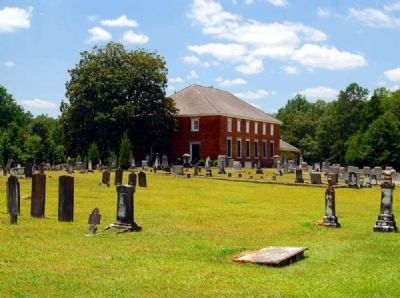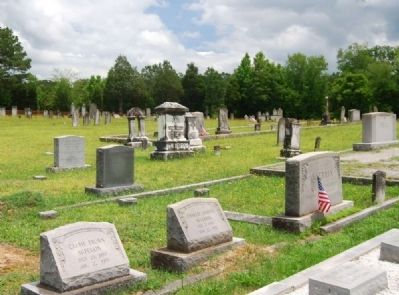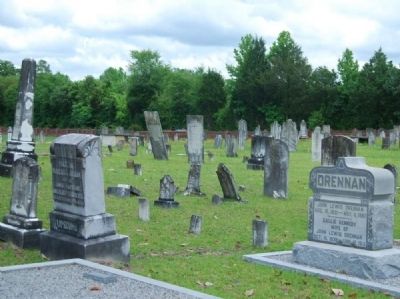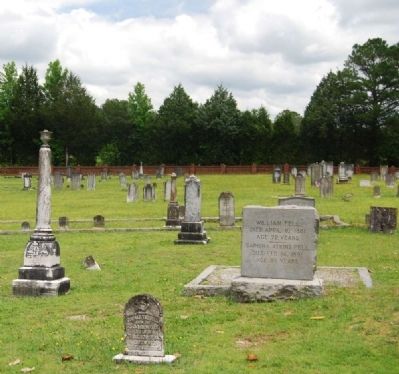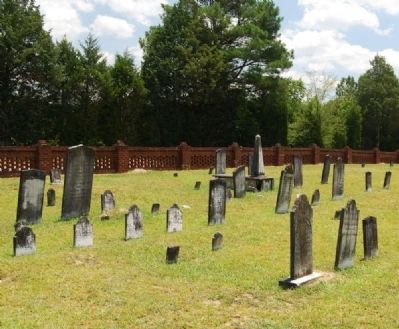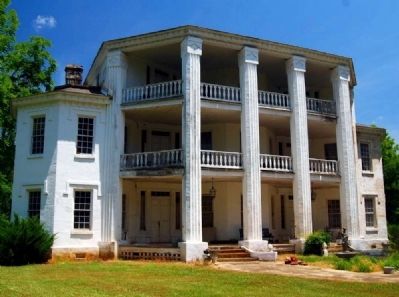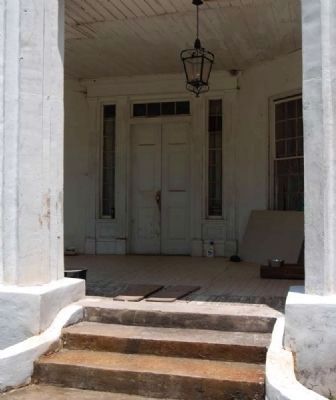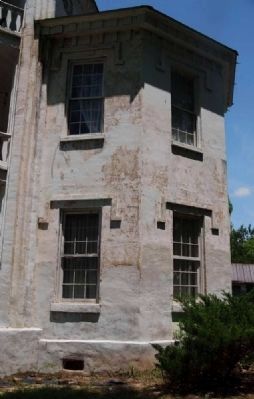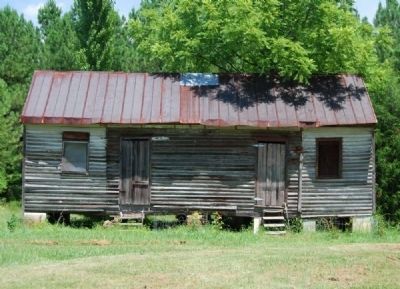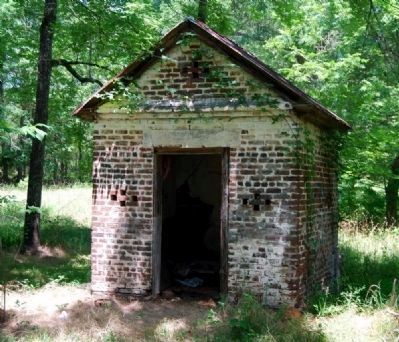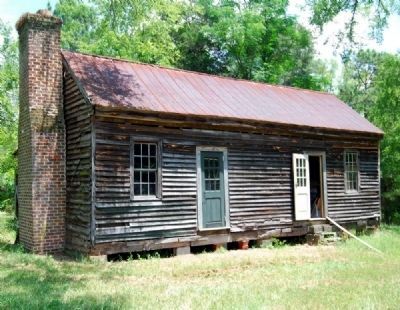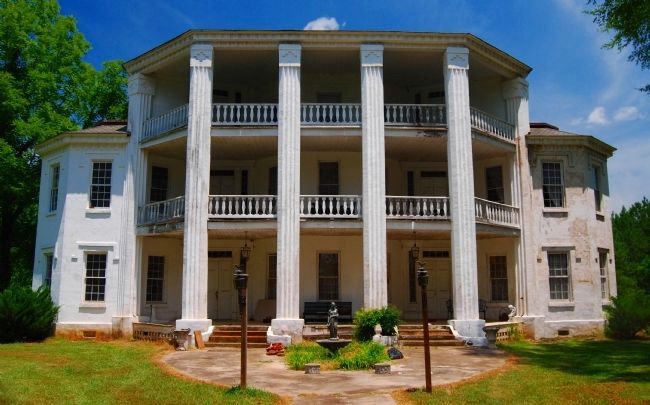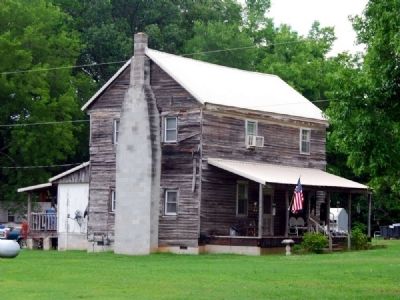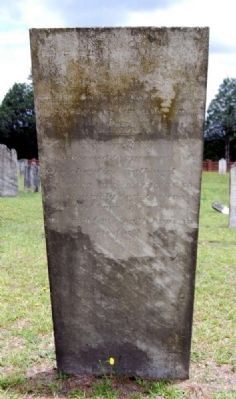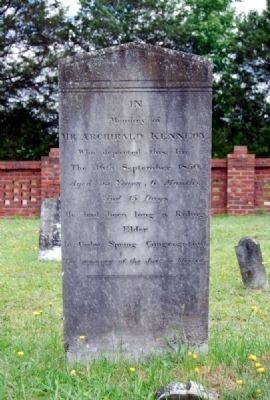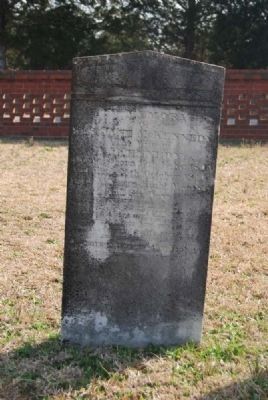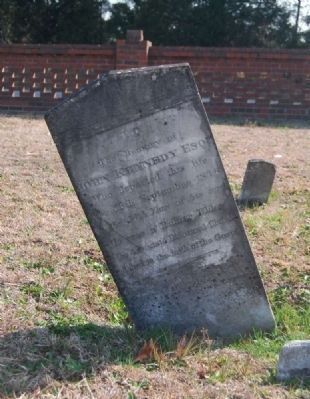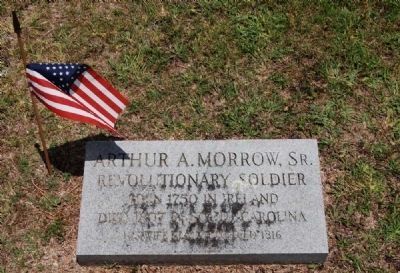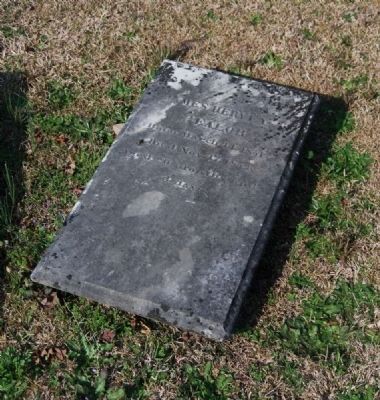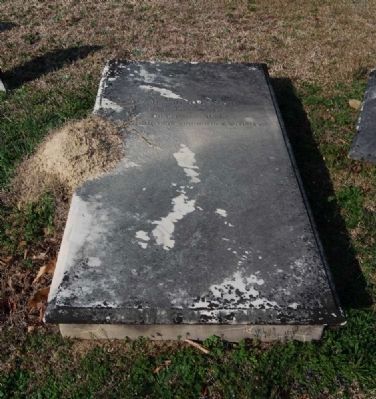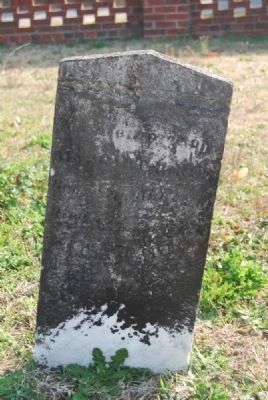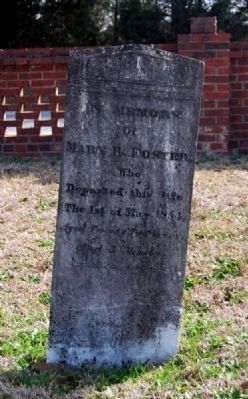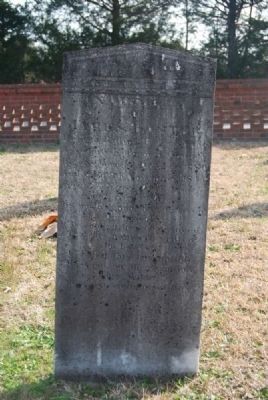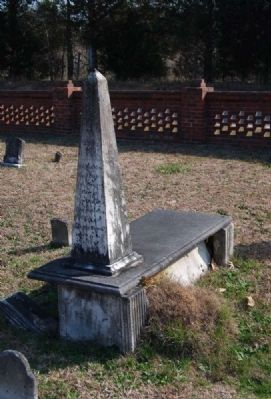Bradley in Greenwood County, South Carolina — The American South (South Atlantic)
Cedar Springs A.R.P. Church
Inscription.
[Front]:
This church was organized 1779-1780 by Dr. Thomas Clark (d. 1791), who had emigrated from Ireland to N.Y. in 1764. Clark moved to this area permanently about 1786, preaching here, at Long Cane (now Lower Long Cane), and at Little Run. He is the father of the Associate Reformed Presbyterian church in the South.
[Reverse]:
The first church, then called Cedar Creek, was a log building 2 mi. SE. The congregation was renamed Cedar Springs in 1790. It moved here and built a frame church in 1791. The cemetery includes graves of several ministers, including Thomas Clark, and many early members. The present brick church was built in 1853.
Erected 2006 by Members and Friends of the Church. (Marker Number 24-18.)
Topics. This historical marker is listed in this topic list: Churches & Religion. A significant historical year for this entry is 1764.
Location. 34° 4.807′ N, 82° 18.119′ W. Marker is in Bradley, South Carolina, in Greenwood County. Marker is on Cedar Springs Road, on the right when traveling east. Touch for map. Marker is in this post office area: Bradley SC 29819, United States of America. Touch for directions.
Other nearby markers. At least 10 other markers are within 7 miles of this marker, measured as the crow flies. Constitution Tree (approx. 3.4 miles away); Parsons Mountain World War II Memorial (approx. 3.4 miles away); Parsons Mountain (approx. 3.4 miles away); Bradley CCC Camp F-7 (approx. 3.9 miles away); Patrick H. Bradley (approx. 3.9 miles away); Historical Promised Land Community (approx. 4.9 miles away); Battle of Long Cane (approx. 6.2 miles away); Long Canes Massacre (approx. 6.3 miles away); a different marker also named Long Canes Massacre (approx. 6.4 miles away); Long Cane Associated Reformed Presbyterian Church (approx. 6.4 miles away). Touch for a list and map of all markers in Bradley.
More about this marker. The marker replaces one erected in 1947. That marker (see picture below) was formerly located at the intersection of Cedar Springs Road and McCormick Highway (South Carolina Highway 10). It read:
Cedar Spring Associate Reformed Presbyterian Church
4.1 miles W. is Cedar Spring Church, organized, 1782. At site on Cedar Creek about 2 miles S. E. of present site, by the Rev. Thos. Clark, M.D., with whom a part of the Scotch members had come from Ballibay, Ireland, in 1764. There Presbytery of Carolinas and Georgia was organized, Feb. 24, 1790; and second Presbytery, Apr. 8, 1801. The present building was erected in 1853.
Erected by members and friends of the church, 1947.
Also see . . .
1. Early Records of Cedar Springs A.R.P. Church. RootsWeb entry:
The following record is a transcript made from the original session book of Cedar Springs Associate Reformed Presbyterian Church (Abbeville District) by Dr. Nora Davis in 1958. (Submitted on July 18, 2009, by Brian Scott of Anderson, South Carolina.)
2. Find a Grave: Cedar Springs A.R.P. Church. This church was organized 1779-1780 by Dr. Thomas Clark (d. 1791), who had emigrated from Ireland to N.Y. in 1764. (Submitted on March 25, 2011, by Brian Scott of Anderson, South Carolina.)
3. An Historical Sketch of the Long Cane A.R.P. Church. The Long Cane Webpage entry:
Fearful of more Indians and of worse barbarity, following the Cherokee and the Creek massacres, the people of the Long Canes settlement took refuge in such neighboring fortified places as they were able to reach, forts prepared for just such emergencies. (Submitted on July 19, 2009, by Brian Scott of Anderson, South Carolina.)
4. Cedar Springs Historic District. The Cedar Springs Historic District, located on the boundary of Greenwood and Abbeville counties in western South Carolina, contains three buildings that remain of the once prosperous farming community of Cedar
Springs. Included are the Frazier-Pressly House (ca. 1852-1856), a massive three-story plantation house; the Cedar Springs Associate Reformed Presbyterian Church (ca. 1853), a two-story brick meetinghouse with cemetery; and a two-story log building (ca. 1820), now covered in shiplap siding and a standing-seam metal roof, which is believed to have been a stagecoach stop. (Submitted on July 18, 2009, by Brian Scott of Anderson, South Carolina.)
5. Cedar Springs Historic District. Cedar Springs Historic District is a historic district in Abbeville and Greenwood Counties in South Carolina. It has three contributing properties. (Submitted on July 18, 2009, by Brian Scott of Anderson, South Carolina.)
6. Frazier-Pressly House. Frazier-Pressley House is an octagon house that is a contributing property in the Cedar Springs Historic District, in Abbeville, South Carolina. (Submitted on July 19, 2009, by Brian Scott of Anderson, South Carolina.)
Additional commentary.
1.
I am a descendant of Thomas Clark living in Maryland. Actually, I am descended from his brother John Clark back in Salem New York. I am not completely sure. My great grandfather was John Anderson Clark who lived in Freeport Illinois and was appointed by President Lincoln to be Surveyor General of
the New Mexico Territory from 1861-1867. I thought it would be interesting to try to learn more about Thomas Clark, so I was fascinated to learn from the marker that Clark had a role in the formation of the A.R.P. though I have very little idea of what that would mean in terms of spirituality or religious practice. I hope someday to visit the gravesite as I recently learned about it through a history book of Abbeville that a friend in my community happened to have, someone also descended from Abbeville, but living in Baltimore, we discovered.
— Submitted February 11, 2009, by William D Clark of Kingsville, Maryland.
2. Cedar Springs Historic District - National Register Nomination Form (1982)
The Cedar Springs Historic District is a rural community on the boundary of Abbeville and Greenwood counties consisting of three major buildings, a church and two residences. The buildings are believed to have been built between ca. 1820 and 1856. The district retains the ambiance of the mid-nineteenth century; only the paving of the road and the construction of a small frame grocery/filling station mark the ingress of contemporary culture. The buildings of the district are still in use.
1. The Stagecoach Inn is a two-story log building, believed to date from ca. 1820. The building has a gable roof covered in standing-seam metal. A shed-roofed porch along the original facade (north elevation) has been enclosed; entrance is effected by a porch-sheltered doorway on the east elevation. Two six-over-six windows flank this doorway, with two similar windows on the second story. The enclosed one-story porch on the north elevation has an attached brick flue and irregular fenestration; two six-over-six windows are on the second story of this elevation. The west elevation features a massive brick chimney laid in Flemish bond. The first story of this elevation has a small shed-roofed ell to the left of the chimney and a single window to the right. The second story has six-over-six windows on the first story and two six-over-six windows on the second story.
The Stagecoach Inn has seen several alterations. The log walls are now sheathed in shiplap siding.
2. The Cedar Springs A.R.P. Church is a large rectangular, brick building with a hip roof. The brickwork is common bond with every sixth course bonding. The foundation is brick and stone. The building was reputedly constructed in 1853, replacing an earlier building. The facade (east elevation) has two bays, with matching doorways having double six-panel doors on the first story and single twelve-over-twelve light windows on the gallery level. The doors and windows have plastered lintels.
the right window has been replaced with six-over-six sash. A small square plastered panel is located midway between the gallery windows.
The south and north elevations have six bays each. The first story windows are nine-over-nine and lave louvered shutters. The gallery windows have been plastered over, except for the easternmost windows, which have been replaced with six-over-six sash. The south elevation has a separate single entrance providing access to the gallery, instead of a window in the first story easternmost bay.
A single story, gable-roofed brick wing was added to the rear of the church in the 1940s.
3. The Frazier-Pressly House is a three-story, stuccoed brick building, believed to have been constructed as a residence for Captain James W. Frazier in 1852-1856. The building is composed of three octagonal sections connected by a hallway that circumscribes the central three-story octagon with a three-story portico defining the facade (south elevation) and a two-story stuccoed brick ell at the rear.
The portico of the Frazier-Presley House features four three-story brick pillars with pilaster responds at the junctures with the house. The brick is laid in a diagonal bias, with vertical channeling resulting. The capitals of the pillars are cubical with recessed brickwork creating stepped diamond panels. A veranda is carried by the
pillars at each level.
Entrance to the house is by six doorways with multi-pane transoms and sidelights; two such entrances at each floor on either side of the central octagon lead to the circumscribing hallway. A seventh entrance is on the forward facet of the central octagon at the third story. each facet of the three octagons features a central window on each floor. These windows are nine-over-nine with stuccoed drip capes. A corbelled brick cornice crowns the second stories of the outermost octagons and the third story of the central octagon. A window's walk originally surmounted the central octagon; this feature and the balconies that originally topped the outermost octagons have deteriorated so that only traces remain. Five brick chimneys, repeating the brick channeling and the stepped diamond panels of the pillars of the portico rise above the roof.
The two-story stuccoed brick ell at the rear of the house has a shed roof. This ell is two bays deep and two wide. The exterior walls between this ell and the two outermost octagonal sections are frame, sheathed in board-and-batten siding, with doorways on the first story. Four octagonal porthole windows, which light the third floor hallway, appear above the shed roof of the ell. A single-story frame ell was added to the north wind of the house ca. 1910.
The house has eleven major rooms, all of which enter onto the central circumscribing hall. Each floor of each octagon is a single room. The third floor of the central octagon was used as a doctor's office by Dr. Joseph L. Pressly in the later nineteenth century. The walls of the house are plaster and feature a decorative crown molding. Twin-run staircases rise at the rear of the central octagon, coming to a common landing on each floor. The fireplaces, located on the north wall of each octagon, feature wooden mantelpieces with engaged columns or pilasters.
The Frazier-Pressly House is surrounded by ornamental trees and shrubs; a cedar-lined drive leads to the house. Surviving buildings include a windmill, several barns and sheds, and a well. The house itself is in poor condition with marked deterioration of the bricks at many points.
4. The Cedar Springs Grocery is a small one-story, frame building, built as a grocery and filling station by a Mr. Rogers ca. 1955. The building has a gable roof, a shed-roofed porch, and a shed-roofed rear ell.
Significance: The Cedar Springs Historic District, located on the boundary of Greenwood and Abbeville counties in western South Carolina, contains three buildings that remain of the once prosperous farming community of Cedar Springs. Included are the Frazier-Pressly House (ca. 1852-1856), a massive three-story plantation house; the Cedar Springs Associate Reformed Presbyterian Church (ca. 1853), a two-story brick meetinghouse with cemetery; and a two-story log building (ca. 1820), now covered in shiplap siding and a standing-seam metal roof, which is believed to have been a stagecoach stop. These buildings are important because they reflect the mid-nineteenth century history of this rural plantation society. In addition, the Frazier-Pressly House is architecturally significant as a unique example of the octagon mode of architecture.
Additional Information: In 1791 the Cedar Springs ARP Church congregation, formerly the Cedar Creek congregation (formed ca. 1779-1780), moved two miles northwest to their present site and constructed a frame house of worship. The present brick church was reputedly built in 1853. A local historian theorizes that small farmers settled near the church in the late eighteenth century. By the beginning of the nineteenth century the less successful farmers moved on, leaving a group of families who accumulated rich land holdings and developed into a local planter class. Other plantations once existed in the immediate area; however, the Frazier-Pressly House is the only residence remaining of the community once centered around cedar Springs A.R.P. Church.
According to local tradition Captain James Frazier constructed his three-story brick plantation home between 1852 and 1856.
In 1875 Frazier's daughter Tallulah and her husband, Dr. Joseph Lowry Pressly, acquired the house. Dr. Pressly has served as a surgeon in the Confederate Army, rising to the rank of major. After his discharge he continued to serve the people of the cedar Springs community as a doctor and teacher of medicine and dentistry. The central room on the third floor of the house served as his office.
The two-story gable-roofed log building adjacent to the Frazier-Pressly House was probably built ca. 1820. Local tradition holds that the building was a stagecoach stop and inn on the road from Augusta, Georgia, to Abbeville and Edgefield. It is likely that the stopping place was established in this location because of the community already developed around the Cedar Springs Church.
Architecture: The Cedar Springs Historic District includes one of South Carolina's unique nineteenth century houses, the Frazier-Pressly House. The Octagon style residential architecture that flourished in the United States from 1848 to 1860 was inspired by the writing of Orson Squire Fowler, whose book, A Home for All or the Gravel Wall and Octagon Mode of Building, was published in 1848. The Zelotes Holmes House in Laurens is one of South Carolina's few Fowler inspired octagonal homes. The Frazier-Pressly House is exceptional in that it is built around three octagons. These three octagonal elements are connected by a hallway circumscribing the central octagonal core of the house and by a massive three-story portico, whose three tiers of porches are reached by seven entrances, all with transoms and sidelights. The composition and plan of the Frazier-Pressly House are believed to be unique in the United States.
— Submitted July 18, 2009, by Brian Scott of Anderson, South Carolina.
3. Cedar Springs A.R.P. Church
Cedar Springs, Abbeville Co. — This historic and ancient church dates from the year 1780. It was about this time that Rev. Thomas Clark, M.D., came from Salem, N.Y., to preach to that part of his congregation which had emigrated from Ballobay, Ireland, in 1764 and settled in Abbeville District, S.C.
The congregation was likely organized in the year 1780, though it was not till the year 1786 that Dr. Clark settled as pastor permanently of Cedar Springs and Long Cane. This good and truly great man labored here for six years. It was his privilege to see the Presbytery of the Carolinas and Georgia organized on the 24th of February, 1790. No record can be found of his installation over Cedar Springs and Long Cane, though we find that the Presbytery ordered his settlement in 1791. Dr. Clark died in 1792, and is buried at Cedar Springs. The first house erected by the congregation was built of logs, about two miles southeast of the present site. The name of the church was derived from a cedar tree near the spring where the first church was built. Some of the first members were Robert Foster, Eliza Sinclair, Mr. Patterson, McBryde, Morrow, Gibson and Robinson. The two churches, Long Cane and Cedar Springs, paid Dr. Clark one hundred pounds, a liberal salary for the time.
The next pastor of Cedar Springs and Long Cane was Rev. Alexander Porter. He was installed April 2, 1798. The congregations at this time were large. The membership was large in the year 1802—520 communicants were reported. At the communion occasions large numbers attended from other churches—from Due West, Rocky Springs and Generostee. Tradition says that 760 observed the sacrament at one time. These communions were great spiritual feasts to the people. They covered five days. Thursday was fast day. Friday applicants for membership were received or kept back, Saturday and Sabbath's services were especially devoted to the sacrament, and Monday was thanksgiving. Many of the important transactions of the Second Presbytery are identified with Cedar Springs and Long Cane. Here the original Presbytery was organized, and here the Second Presbytery was constituted April 8th, 1801. On account of Mr. Porter's health and the uncommon largeness of his pastoral charge he asked to be relieved of one of his churches, and accordingly gave up Long Cane September 15th, 1803, and the next year was installed as pastor of Cedar Springs alone.
Mr. Porter continued pastor of Cedar Springs until 1813. The next year Mr. Porter moved with a number of his congregation to Ohio. For a number of years Cedar Springs was vacant and the church suffered just as her sister congregation of Long Cane, on account of a destitution of ordinances.
In the year 1817 Rev. John T. Pressly was ordained and installed pastor. This proved to be an excellent choice. Dr. Pressly's pastorate was abundantly blessed. He is described as being "a man untiring in labor, punctual to every engagement, and faithful in preaching the gospel and watching for souls." Cedar Springs under his ministry reached the zenith of her glory. She numbered five hundred communicants without the help of Long Cane. It was at this period that the church gave three young men to the ministry — Rev. Samuel P. Pressly, D.D., Rev. E.E. Pressly, D.D., and Rev. James P. Pressly, D.D. Dr. John T. Pressly conducted the Theological Seminary here at Cedar Springs. He was the sole professor. Among the numerous active and useful members were the Fosters, McBrydes, Devlins, Youngs, McCrearys and Presslys. Later on came such men as the Kennedy's Morris, Col. John Herst, Wm. Patton, Hamilton Hill, and others. During this time Dr. Pressly supplied Long Cane occasionally, though he was not installed pastor over the united charge until the year 1828. The two congregations were then reunited and continued for a long time to constitute one pastorate. The church was much weakened during Dr. Pressly's pastorate, that is, the latter part of it, by emigration to the West and Southwest. It was her diminishing numbers that reconciled Cedar Springs to the arrangement of sharing her pastor with her sister church. Political discussion also interfered very much with the progress of religion. It was the time of Nullification and Abbeville County seemed to be the center of the fight for that principle. Dr. John T. Pressly discouraged possibly by the constant emigration and by the high political ferment, accepted a call to Allegheny, Pa., in the year 1831. After him there was a vacant period for about six years. Rev. W. R. Hemphill was called and settled as pastor in 1837. For eleven years he labored diligently among this people. His pastorate was abundantly blessed — as many as thirty five connecting in one year with the church. In 1848 Dr. Hemphill was chosen to a professorship in Erskine College, and demitted his charge. His people gave him up with the greatest reluctance. During his pastorate three ministers went out from the church — Rev. W.W. Patton, Rev. Samuel Morris and Rev. D.P. Robinson. Revs. J.M. Young, David Pressly, Joseph Pressly and J.E. Pressly were born and partly raised in Cedar Springs and Long Cane. Rev. H.T. Sloan was called and settled as pastor in November, 1850. This was the beginning of one of the most fruitful pastorates in the Synod. Faithfully and earnestly did Dr. Sloan do his work as pastor for forty years. In 1890 he demitted his charge, but continued to preach until a short time before his death. He died February 13th, 1894. There were several seasons of revival during Dr. Sloan's ministry, and the church experienced great prosperity; but there was a constant drain on the membership—a number going off to Troy, a new congregation organized in 1882, some to Due West and other places. In September, 1894, Dr. Robert Lathan was chosen pastor of Cedar Springs and Bradley, the latter being a part of the congregation but with a different house of worship. Dr. Lathan's ministry was terminated by his death, which occurred June 15th, 1896. His work in this field was short, but it left its impress upon the people. After him Rev. D.G. Phillips, Jr., was chosen, Jan. 1897, and remained until December. 1901. The present church at Cedar Springs was built in 1853, during the pastorate of Dr. Sloan. (Source: The Centennial History of the Associate Reformed Presbyterian Church 1803-1903 by James Boyce pg 437.)
— Submitted July 19, 2009, by Brian Scott of Anderson, South Carolina.
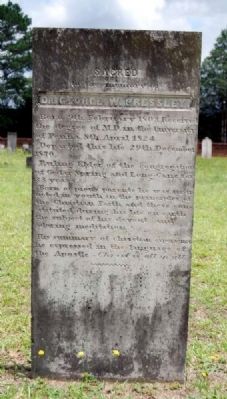
Photographed By Brian Scott, June 6, 2009
26. Dr. George Pressley Tombstone
to the Memory of
Dr. George W. Pressley
Born 9th February 1803. Received
the degree of M.D. in the University
of Penn'a 9th April 1824.
Departed this life 29th December 1870.
Ruling Elder of the congregation
of Cedar Springs and Long Cane for
23 years.
Born of pious parents be was
inducted in youth in the principles of
the Christian Faith and these
constituted during his life on earth
the subject of his devout and
adoring meditation.
His summary of christian experience
he expressed in the language of
the Apostle. Christ is all in all.
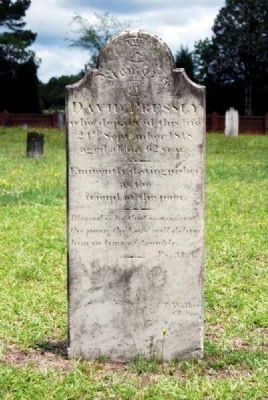
Photographed By Brian Scott, June 6, 2009
28. David Pressly Tombstone
Memory
of
David Pressly
who departed this life
21st September 1818
aged 62 years ----•----
Eminently distinguished
as the
friend of the poor.
----•----
Blessed is he that considers
the poor; the Lord will deliver
him in time of trouble. Ps. 11.1
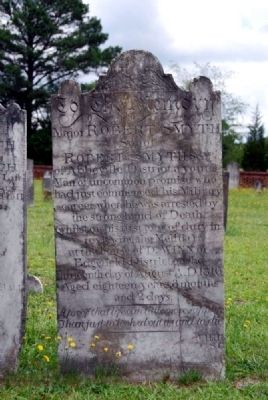
Photographed By Brian Scott, June 6, 2009
29. Maj. Robert Smith Tombstone
of
Major Robert Smyth
Son of
Robert Smythe Sr.
of Abbeville District, a young
Man of uncommon promise who
had just commenced his Military
career, when he was arrested by
the strong hand of Death,
(whilst on his first tour of duty in
reviewing the Militia)
at the house of D. Winn in
Edgefield District on the
thirteenth day of August A.D. 1816,
aged eighteen years, 8 months
and 2 days.
----------
A proof that life can little more supply
Than just to look about us and to die..
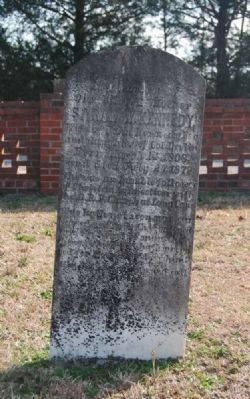
Photographed By Brian Scott, March 14, 2011
33. Sarah W. Kennedy Tombstone
to the Memory of
Our Beloved Mother
Sarah W. Kennedy
Wife of John Kennedy, Esq.
and daughter of Col. Devlin.
Born March 14, 1808
and died July 27, 18793
She was an humble follower
of Christian ----- with
the A.R.P. Church at Long Cane.
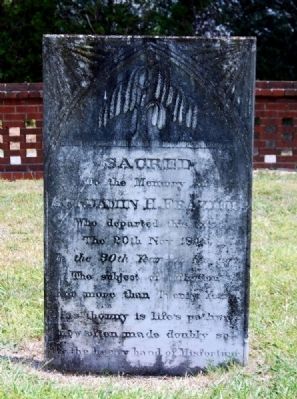
Photographed By Brian Scott, July 4, 2009
34. Benjamin H. Frazier Tombstone
To the Memory of
Benjamin H. Frazier
Who departed this life
The 20th Nov. 1841
In the 30th Year of his life.
The subject of affliction
for more than Twenty Years
How thorny is life's pathway
How often made Doubly so
by the hearty hand of Misfortune.
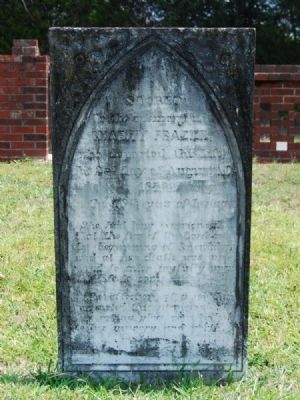
Photographed By Brian Scott, July 4, 2009
35. Charity Frazier Tombstone
to the Memory of
Charity Frazier
who departed this life
the 2nd day of August A.D.
1852
in the 75th year of her age.
She had long experienced
that the fear of the Lord is
the beginning of knowledge,
and at her death was permitted
to enter joyfully upon
the life to come.
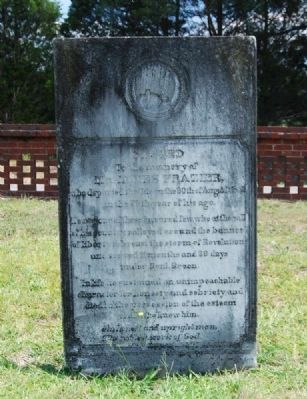
Photographed By Brian Scott, July 4, 2009
36. James Frazier Tombstone
To the Memory of
Mr. James Frazier
who departed this life on the 30th of Aug A.D. 1842
in the 76th year of his age.
He was one of those favoured few who at the call
of his country ralleyed around the banner
of liberty to breast the storm of Revolution
and served 11 months and 20 days
under Genl. Green.
In life he sustained an unimpeachable
character for honesty and sobriety and
died in the possession of the esteem
of all who knew him.
An honest and upright man,
The noblest servant of God.
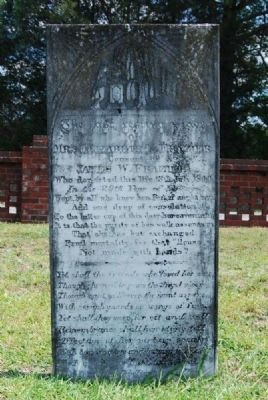
Photographed By Brian Scott, July 4, 2009
37. Elizabeth Frazier Tombstone
of
Mrs. Elizabeth Frazier
Consort of
James Frazier
Who departed this life 18th of July 1844
In the 29th Year of her Life
Wept by all who knew her
Add one drop of consolation
To the bitter cup of this deep bereavement
It is that the purity of her walk assures us
That she has but exchanged
Frail mortality, for that "House
Not made with hands"
----------
Yet shall the friends who lived her weep
Though shunned in peace the Angel sleep
Though wept in Heaven the saint aspire
With seraph guards on wings of fire.
Yet shall they weep o oft and well
Remembrance shall her story tell
Affection of her virtues speak.
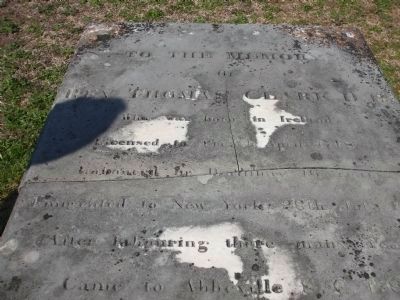
Photographed By Harriet Creswell, April 1, 2011
47. Dr. Clark's Gravesite
(Inscription) Who was born in Ireland. Licensed to preach Apr.1748. Labored in Ballibay 16 yrs. Emigrated to N.Y. 28 July, 1746, after laboring many yrs. came to Abbeville, SC 1786 where he labored as the Founder and 1st pastor of Cedar Spring and Long Cane until his death Dec. 26, 1792.
Credits. This page was last revised on February 22, 2022. It was originally submitted on April 17, 2008, by Brian Scott of Anderson, South Carolina. This page has been viewed 6,709 times since then and 80 times this year. Photos: 1. submitted on July 13, 2008, by Harriet Creswell of Bradley, South Carolina. 2. submitted on April 17, 2008, by Brian Scott of Anderson, South Carolina. 3. submitted on July 13, 2008, by Harriet Creswell of Bradley, South Carolina. 4, 5, 6. submitted on July 19, 2009, by Brian Scott of Anderson, South Carolina. 7. submitted on April 18, 2008, by Brian Scott of Anderson, South Carolina. 8, 9. submitted on July 18, 2009, by Brian Scott of Anderson, South Carolina. 10. submitted on July 19, 2009, by Brian Scott of Anderson, South Carolina. 11. submitted on July 18, 2009, by Brian Scott of Anderson, South Carolina. 12. submitted on July 19, 2009, by Brian Scott of Anderson, South Carolina. 13, 14. submitted on July 18, 2009, by Brian Scott of Anderson, South Carolina. 15, 16, 17, 18, 19, 20, 21, 22, 23, 24. submitted on July 19, 2009, by Brian Scott of Anderson, South Carolina. 25. submitted on July 18, 2009, by Brian Scott of Anderson, South Carolina. 26, 27, 28, 29, 30. submitted on July 19, 2009, by Brian Scott of Anderson, South Carolina. 31, 32, 33. submitted on March 25, 2011, by Brian Scott of Anderson, South Carolina. 34, 35, 36, 37, 38. submitted on July 19, 2009, by Brian Scott of Anderson, South Carolina. 39, 40, 41, 42, 43, 44, 45, 46. submitted on March 25, 2011, by Brian Scott of Anderson, South Carolina. 47. submitted on April 4, 2011, by Harriet Creswell of Bradley, South Carolina. 48. submitted on May 22, 2011, by Harriet Creswell of Bradley, South Carolina. • Craig Swain was the editor who published this page.
